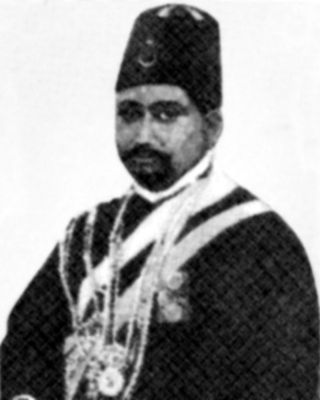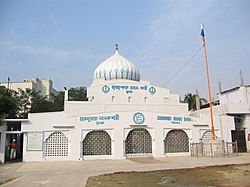
Syed Ismail Hossain Siraji was a Bengali author and poet from Sirajganj in present-day Bangladesh. He is considered to be one of the key authors of period of the Bengali Muslim reawakening; encouraging education and glorifying the Islamic heritage. He also contributed greatly to introducing the Khilafat Movement in Bengal, and provided medical supplies to the Ottoman Empire during the Balkan Wars. Anal-Prabaha, his first poetry book, was banned by the government and he was subsequently imprisoned as the first South Asian poet to allegedly call for independence against the British Raj. The government issued Section 144 against him 82 times in his lifetime.

Dhaka (Dacca) is one of the oldest inhabited mega cities of the World. The history of Dhaka begins with the existence of urbanised settlements in the area that is now Dhaka dating from the 7th century CE. The city area was ruled by the Hindu Gauda Kingdom, Buddhist and Shaivite Pala Empire before passing to the control of the Hindu Sena dynasty in the 10th century CE. After the Sena dynasty, the city was ruled by the Hindu Deva Dynasty. Dhaka was successively ruled by the Turkic and Afghan governors descending from the Delhi Sultanate, followed by the Bengal Sultanate, before the arrival of the Mughals in 1608. The city became proto-industrialised and declared capital of the Mughal Bengal and commercial (financial) capital of the Mughal India. The Dhaka natural riverine port has a recorded existence since the 16th century CE. Dhaka's strategic riverine location in Bengal made it a hub for Eurasian traders, including Armenians, the Portuguese, French, Dutch and British. The bustling old city was known as the Venice of the East. After Mughals, British ruled the region for 200 years until the independence of India in 1947. After the independence of Bangladesh in 1971, Dhaka became the capital of the new state.

Hakim Habibur Rahman was an Unani physician, litterateur, journalist, politician and chronicler in early 20th-century Dhaka.

Shamsuddīn Aḥmad Shāh was the last Sultan of Bengal belonging to the House of Ganesha. He was the son and successor of Sultan Jalaluddin Muhammad Shah. After his father's death, he ascended the throne at the age of 14.

Nāsir ad-Dīn Naṣrat Shāh, also known as Nusrat Shah, was the second Sultan of Bengal belonging to the Hussain Shahi dynasty. He continued with his father's expansionist policies but by 1526, had to contend with the Mughal ascendency in the Battle of Ghaghra. Simultaneously, Nasrat Shah's reign also suffered a reverse at the hands of the Ahom kingdom. The reigns of Alauddin Husain Shah and Nasrat Shah are generally regarded as the "golden age" of the Bengal Sultanate.
Ruknuddīn Bārbak Shāh was the son and successor of Sultan Nasiruddin Mahmud Shah. Initially appointed as the governor of Satgaon during the reign of his father, Barbak ascended the throne of the Bengal Sultanate in 1459. He was the first ruler to give prominent roles in the Sultanate's administration to the Abyssinian community. Historian Aniruddha Ray credits Barbak Shah as the pioneer of urbanisation in Bengal.
Jalaluddin Fateh Shah was the last ruler of later Ilyas Shahi dynasty of the Bengal Sultanate reigning from 1481 to 1487. He was the uncle and successor of Sultan Shamsuddin Yusuf Shah.
Sidi Badr, later known by his regnal name Shams ad-Dīn Muẓaffar Shāh, was the Sultan of Bengal from 1490 to 1494. Described by the Indo-Persian historians as a tyrant, his cruelty was said to have alienated the nobles as well as his common subjects.
Musa Khan was the leader of the Bara-Bhuiyans of Bengal following the death of his father, Isa Khan.
Shāhzāda Bārbak, known by his regnal title as Ghiyāsuddīn Bārbak Shāh, was the Sultan of Bengal in 1487 and the founder of the Sultanate's Habshi dynasty. He was a former commander of the palace-guards of Jalaluddin Fateh Shah court.

Malik Andil Habshi, better known by his regnal title Saifuddin Firuz Shah was the second "Habshi" ruler of the Bengal Sultanate's Habshi dynasty. He was a former army commander of the Sultanate's Ilyas Shahi dynasty.

Mohammad Mozammel Huq was a Bengali-language poet, novelist, magistrate and educationist. His writings were said to have been inspired by a "Muslim renaissance".
Nawab Bahadur was a title of honour bestowed during Mughal Empire and later during British Raj to Indian Muslim individuals for faithful service or acts of public welfare.
Masum Khan was a zamindar of Bengal. He was the eldest son and successor of Baro-Bhuiyan leader Musa Khan and the grandson of Isa Khan.

Shāh ʿAlī al-Baghdādī was a 15th-century Muslim missionary and Sufi saint based in the Faridpur and Dhaka regions of Bengal.
Ashrafuddin Ahmad Chowdhury was a Bengali politician who had served as general secretary of the Congress Party's Bengal branch, member of the East Bengal Legislative Assembly and later as the Education Minister of Pakistan. He was an advocate of Huseyn Shaheed Suhrawardy's United Bengal proposal.

Syed Abdul Majid, CIE, also known by his nickname Kaptan Miah, was a politician, lawyer and entrepreneur. He is notable for pioneering the development in the agricultural and tea industry in British India as well as his contributions to both secular and Islamic education in Sylhet.
The Kohinoor was a Bengali language newspaper, first published in July 1898. Initially focusing on miscellaneous topics such as Islamic culture, its third relaunch was a pivot of Hindu-Muslim harmony. The paper targeted both Hindu and Muslim clientele.

Tanda, also known as Tandah and Khwaspur Tandah, was a historic 16th-century city of Bengal in the eastern part of South Asia, and one of the most prominent medieval capitals; serving the Karrani Sultans of Bengal and the early Mughal governors of Bengal.

The Greater Jessore region predominantly includes the districts of Jessore, Jhenaidah, Narail and Magura in Bangladesh, as well as the Bangaon subdivision of India. Nestled close to the Sundarbans, the region experienced human settlement early on. It served as the capital city of the Samatata realm and passed through several Buddhist and Hindu kingdoms such as the Palas and Senas. Jessore was ruled by Khan Jahan Ali of Khalifatabad, under the Muslim Sultanate of Bengal, who is credited with establishing the Qasbah of Murali and urbanising the region through advancements in transportation and civilization. Jessore later came to be ruled by various chieftains such as Pratapaditya and became familiar to contemporary European travellers as Chandecan before being annexed to the Mughal Empire in the seventeenth century. By 1757, the British East India Company had dominated and started to establish themselves in the region. British rule lasted up until 1947, with Jessore coming under the Provisional Government of Bangladesh from 1971 onwards.











